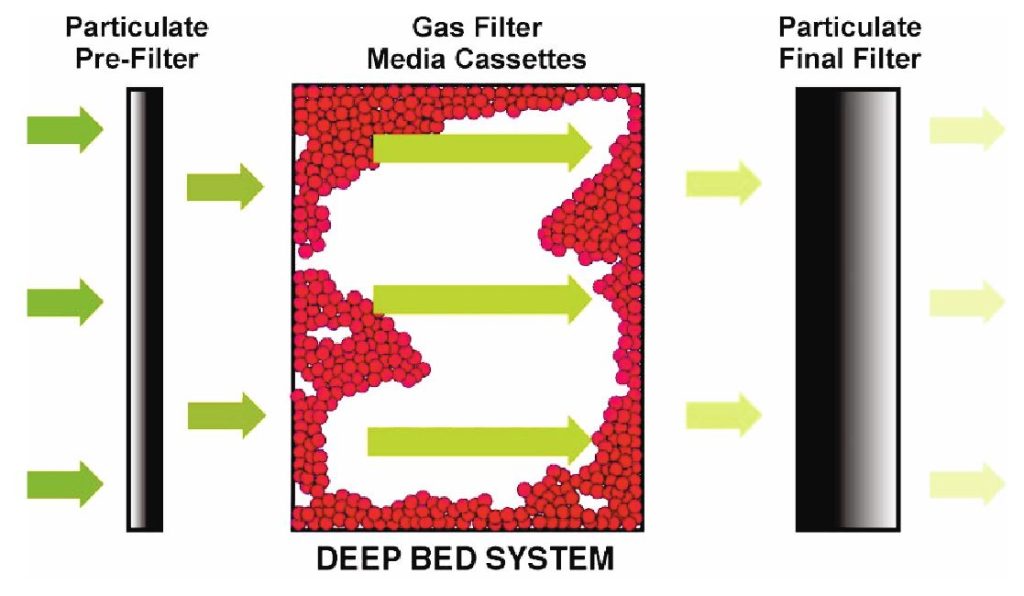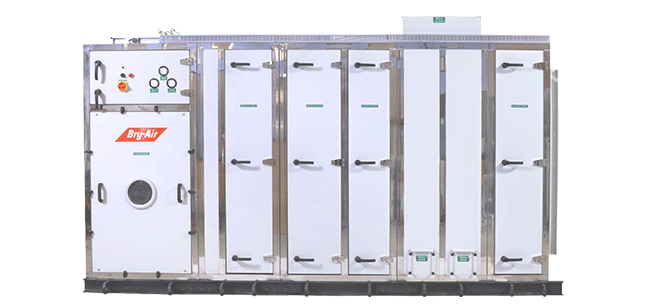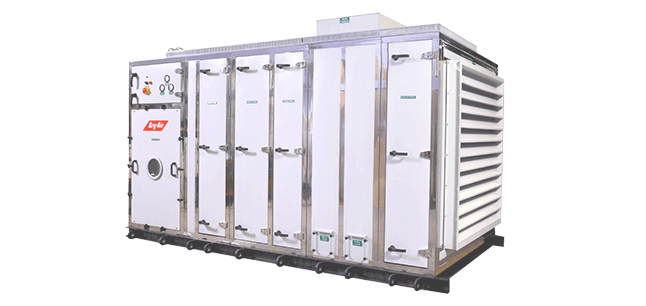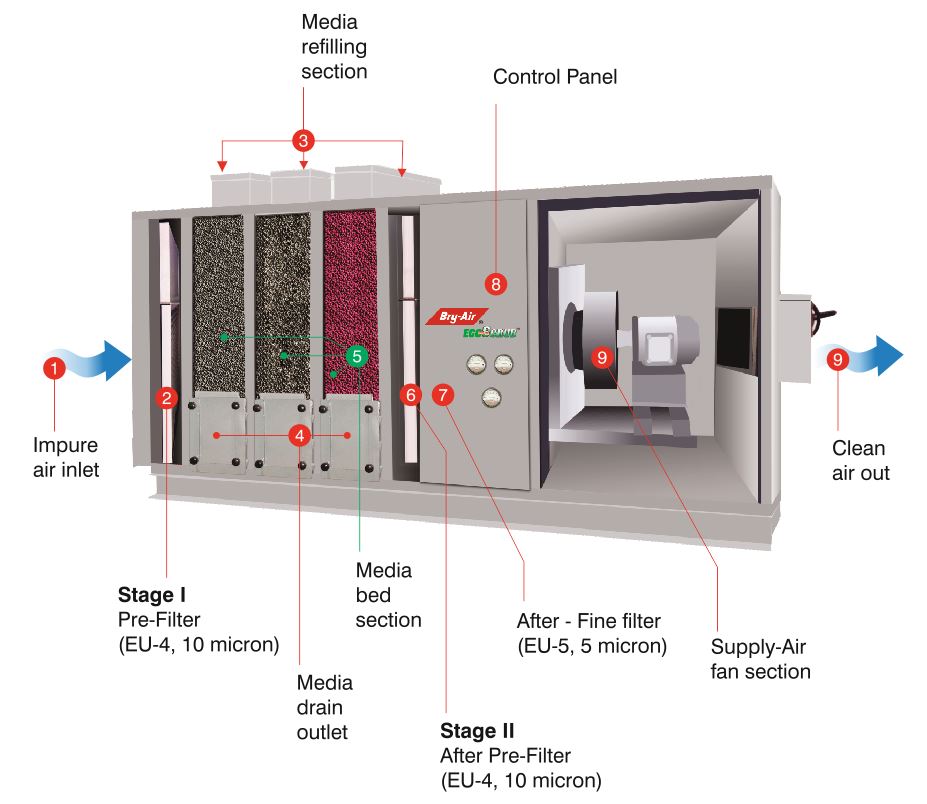EcoScrub™ Deep Bed industrial air filtration systems are used for ‘fresh air treatment and pressurisation’ applications in industry when the level of airborne contamination is very high and a good quantity of media holding is a necessity for prolonged uninterrupted use, before media gets completely spent and replacement becomes inevitable. Deep Bed Systems are powered units of horizontal configuration.
Bry-Air EcoScrub Gas Phase Filtration (GPF) system is an ideal and most cost-effective solution for airborne contamination. Its unique process not only cleans the contaminated air of suspended particles and corrosive gases but is also used for odour removal, making the working environment healthy for you and your electronic equipment.
With rapid industrialisation, electronic equipment and devices are being used across various industries to meet growing demand for more efficient products and services. This has led to the deterioration of the environment, giving rise to airborne contamination. Consequently, there is increasing pressure on the environment to accept higher levels of pollutants than it can safely eliminate.
Atmospheric air, especially in the manufacturing industry, is laden with gaseous chemicals which are corrosive in nature such as hydrogen sulphide (H2S), sulphur oxides(SOx), nitrogen oxides(NOx), chlorine(Cl2), ammonia(NH3), mercaptans (CH4S), hydrocarbons etc. Needless to say, these are generated during the manufacturing processes, and eventually mix with the surrounding air. Common examples are fuel combustion related by-products, gases generated during complex chemical processes, automotive fumes, etc. Other than the problem of ‘outside’ impure air, in many cases, such as in enclosed commercial establishments, contaminants are generated either from or within the space, e.g., tobacco smoke, formaldehyde and other organic compounds from paint and furnishings, food smells etc.
Bry-Air EcoScrub™ Deep Bed Systems are designed on the basis of known parameters related to airflow, types and concentrations of impurities present in the air, space availability and desired media life.

It consists of either single or multiple, perforated hollow housing(s), also called bed(s) filled with chemical media, of at least 305 mm (12” or 1’) thickness. These beds are placed perpendicular to the direction of flow of air.
BRYSORB™ Chemical Media consists of spherical/cylindrical porous pellets that are a combination of Activated Carbon and Activated Alumina impregnated with proprietary chemicals. It cannot be regenerated, so it needs to be replaced whenever it is consumed.
Bry-Air has an in-house lab for regular media assessments, ensuring timely replacements. We offer a service to evaluate the ‘life’ of the chemical media, providing you with the necessary information for efficient maintenance.
For any media replacement, reach us: bryairmarketing@pahwa.com
The working of Bry-Air EcoScrubTM Deep Bed System is simple. The contaminated air first passes through pre-filters which traps the suspended particles, and then through the required chemical media beds, which chemically destroys or removes any remaining gaseous impurities. The chemical media can be activated carbon and/or activated alumina impregnated with proprietary chemicals, used alone or in combination – depending on the type and concentration of the impurities present in the air stream. EcoScrubTM Systems are designed to operate and maintain contaminant gas levels at 1 ppb (parts per billion) or less.
|
Model**
|
Air Flow
|
ESP (Pa)
|
Motor
|
Power* Required
|
Approx. Weight (Kg)
|
|
CMH
|
CFM
|
KW
|
VAC/Φ/Hz
|
TH1
|
TV2
|
|
BPU-500-T-1
|
850
|
500
|
250
|
0.75
|
415/3/50
|
210
|
175
|
|
BPU-500-T-2
|
850
|
500
|
250
|
0.75
|
415/3/50
|
245
|
208
|
|
BPU-500-T-3
|
850
|
500
|
250
|
1.12
|
415/3/50
|
270
|
229
|
|
BPU-1000-T-1
|
1700
|
1000
|
250
|
1.12
|
415/3/50
|
240
|
204
|
|
BPU-1000-T-2
|
1700
|
1000
|
250
|
1.49
|
415/3/50
|
270
|
229
|
|
BPU-1000-T-3
|
1700
|
1000
|
250
|
1.49
|
415/3/50
|
300
|
255
|
|
BPU-1500-T-1
|
2550
|
1500
|
250
|
2.24
|
415/3/50
|
320
|
272
|
|
BPU-1500-T-2
|
2550
|
1500
|
250
|
2.24
|
415/3/50
|
375
|
319
|
|
BPU-1500-T-3
|
2550
|
1500
|
250
|
3.73
|
415/3/50
|
440
|
374
|
|
BPU-2000-T-1
|
3400
|
2000
|
250
|
3.73
|
415/3/50
|
375
|
319
|
|
BPU-2000-T-2
|
3400
|
2000
|
250
|
3.73
|
415/3/50
|
445
|
378
|
|
BPU-2000-T-3
|
3400
|
2000
|
250
|
3.73
|
415/3/50
|
570
|
484
|
*Units suitable for other systems voltages and frequencies viz. 200/220/240/380/440/460 VAC, 3Ph, 50/60, also available on request.
**Data common for both, Horizontal and Vertical unit
1. Deep Bed – Horizontal units
2. Thin Bed – Vertical units
ALL DATA SUBJECT TO CHANGE WITHOUT NOTICE
To know more about Vertical Units, visit: https://www.bryair.com/products/thin-bed-systems/













